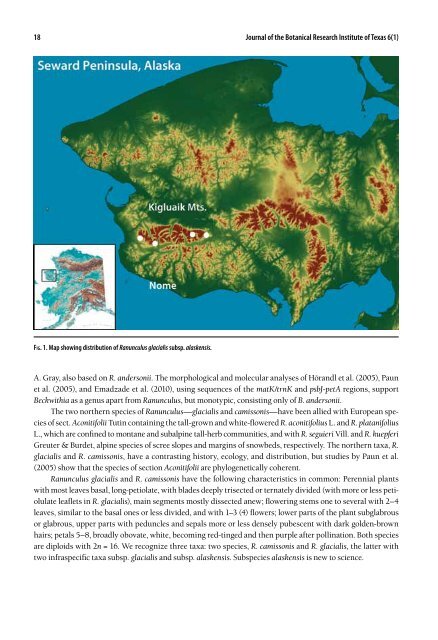Boris A. Yurtzev David F. Murray Reidar Elven - Botanical Research ...
Boris A. Yurtzev David F. Murray Reidar Elven - Botanical Research ...
Boris A. Yurtzev David F. Murray Reidar Elven - Botanical Research ...
Create successful ePaper yourself
Turn your PDF publications into a flip-book with our unique Google optimized e-Paper software.
18 Journal of the <strong>Botanical</strong> <strong>Research</strong> Institute of Texas 6(1)<br />
Fig. 1. Map showing distribution of Ranunculus glacialis subsp. alaskensis.<br />
A. Gray, also based on R. andersonii. The morphological and molecular analyses of Hörandl et al. (2005), Paun<br />
et al. (2005), and Emadzade et al. (2010), using sequences of the matK/trnK and psbJ-petA regions, support<br />
Beckwithia as a genus apart from Ranunculus, but monotypic, consisting only of B. andersonii.<br />
The two northern species of Ranunculus—glacialis and camissonis—have been allied with European species<br />
of sect. Aconitifolii Tutin containing the tall-grown and white-flowered R. aconitifolius L. and R. platanifolius<br />
L., which are confined to montane and subalpine tall-herb communities, and with R. seguieri Vill. and R. kuepferi<br />
Greuter & Burdet, alpine species of scree slopes and margins of snowbeds, respectively. The northern taxa, R.<br />
glacialis and R. camissonis, have a contrasting history, ecology, and distribution, but studies by Paun et al.<br />
(2005) show that the species of section Aconitifolii are phylogenetically coherent.<br />
Ranunculus glacialis and R. camissonis have the following characteristics in common: Perennial plants<br />
with most leaves basal, long-petiolate, with blades deeply trisected or ternately divided (with more or less petiolulate<br />
leaflets in R. glacialis), main segments mostly dissected anew; flowering stems one to several with 2–4<br />
leaves, similar to the basal ones or less divided, and with 1–3 (4) flowers; lower parts of the plant subglabrous<br />
or glabrous, upper parts with peduncles and sepals more or less densely pubescent with dark golden-brown<br />
hairs; petals 5–8, broadly obovate, white, becoming red-tinged and then purple after pollination. Both species<br />
are diploids with 2n = 16. We recognize three taxa: two species, R. camissonis and R. glacialis, the latter with<br />
two infraspecific taxa subsp. glacialis and subsp. alaskensis. Subspecies alaskensis is new to science.
















